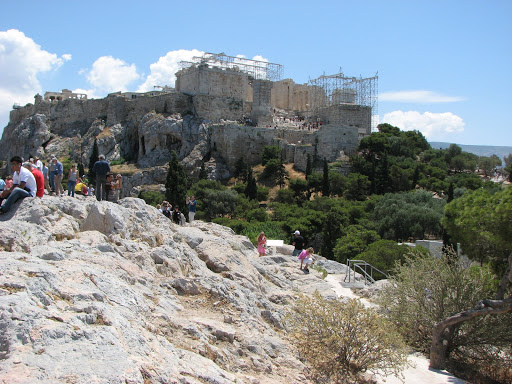Most visitors to Acropolis of Athens arrive and leave by the same route through the Plaka. For a increasingly panaromic option its worth taking the time to explore the area to the west of the Acropolis dominated by the Hills.
Areopagus (M ars Hill)
ars Hill)
It is a historic hunk of rock found near the entrance to the Acropolis, just above the site of the Ancient Agora. Ares was supposed to have been tried here by the Gods for the murder of Poseidon's son Alirrothios. Aeschylus used this setting in ‘The Eumenides’ for the trial of Orestes who pursued by ‘the Furies’ demand of ‘a life for a life’ for killing his stepmother Clytemnestra and her lover Aegisthus. This served as the site of the homicide court and was the meeting ground of the elders in Ancient Athens. It was used as a campsite by the Persians during their seige of Athens. In the Roman era it was used by Saint Paul who preached the ‘sermon of an unknown God’ from here. Amognst his many converts was Dionysius who later became the patron saint of the city.
It is a historic hunk of rock found near the entrance to the Acropolis, just above the site of the Ancient Agora. Ares was supposed to have been tried here by the Gods for the murder of Poseidon's son Alirrothios. Aeschylus used this setting in ‘The Eumenides’ for the trial of Orestes who pursued by ‘the Furies’ demand of ‘a life for a life’ for killing his stepmother Clytemnestra and her lover Aegisthus. This served as the site of the homicide court and was the meeting ground of the elders in Ancient Athens. It was used as a campsite by the Persians during their seige of Athens. In the Roman era it was used by Saint Paul who preached the ‘sermon of an unknown God’ from here. Amognst his many converts was Dionysius who later became the patron saint of the city.
For more information click on: http://www.destination360.com/europe/greece/areopagus-hill.php
Filopappou (Hill of Muses)
The "Hill of the Muses", as it was known in ancient times, is situated within walking distance of Old Athens and offers some of the finest views of Athens (from the Saronic Gulf to the Argolic Hills. Its summit is capped by a monument to a Roman Senator. Northwest along the main path is church Ayios Dhimitrios and in the cliff-face across to the south there is a kind of cave dwelling known as the Prison of Socrates. It also shares some negative history. The shell that destroyed the roof of the Parthenon was lobbed from here. In 1967 during the coup, tanks were placed by the military on its slopes and in recent times this place is best avoided at night as there have been quite a few instances of crime. For more information click on: http://www.athensinfoguide.com/wtsphilopappou.htm
Pnyx ( Hill of Pnyx)
Hill of Pnyx)
To the west of the Acropolis, the Pnyx is a rocky hill surrounded by parks. In ancient Athens this was used as the site for the gathering of the Democratic Assembly. It was literally the cradle of democracy, the Athenians used to gather here to discuss political issues and to take decisions on the future of their town. Later with the growth of Athens the Assembly was shifted to the Theatre of Dionysos. Apart from the platform of the Pnyx, other ancient remains include two large stoas, built to shelter people in case of bad weather, the altar of Zeus Agoraios and the sanctuary of Zeus Hypsistos. Beyond the Pnyx lies ‘Hill of Nymphs’ dominated by an observatory & gardens. For more information click on: http://en.wikipedia.org/wiki/Pnyx
Filopappou (Hill of Muses)
The "Hill of the Muses", as it was known in ancient times, is situated within walking distance of Old Athens and offers some of the finest views of Athens (from the Saronic Gulf to the Argolic Hills. Its summit is capped by a monument to a Roman Senator. Northwest along the main path is church Ayios Dhimitrios and in the cliff-face across to the south there is a kind of cave dwelling known as the Prison of Socrates. It also shares some negative history. The shell that destroyed the roof of the Parthenon was lobbed from here. In 1967 during the coup, tanks were placed by the military on its slopes and in recent times this place is best avoided at night as there have been quite a few instances of crime. For more information click on: http://www.athensinfoguide.com/wtsphilopappou.htm
Pnyx (
 Hill of Pnyx)
Hill of Pnyx)To the west of the Acropolis, the Pnyx is a rocky hill surrounded by parks. In ancient Athens this was used as the site for the gathering of the Democratic Assembly. It was literally the cradle of democracy, the Athenians used to gather here to discuss political issues and to take decisions on the future of their town. Later with the growth of Athens the Assembly was shifted to the Theatre of Dionysos. Apart from the platform of the Pnyx, other ancient remains include two large stoas, built to shelter people in case of bad weather, the altar of Zeus Agoraios and the sanctuary of Zeus Hypsistos. Beyond the Pnyx lies ‘Hill of Nymphs’ dominated by an observatory & gardens. For more information click on: http://en.wikipedia.org/wiki/Pnyx




No comments:
Post a Comment